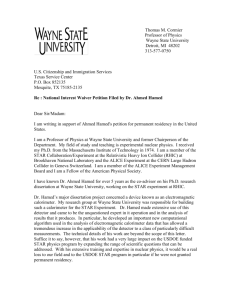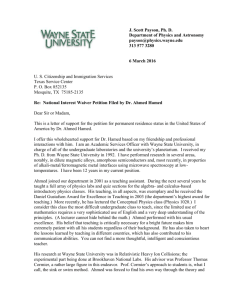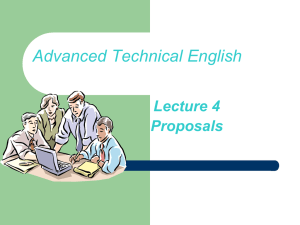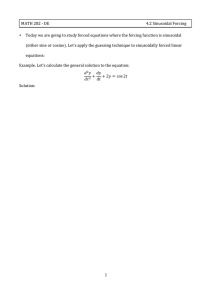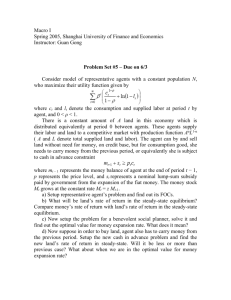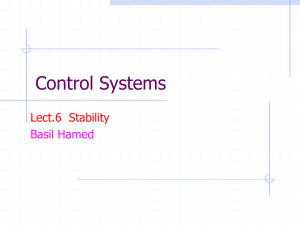Control Systems
advertisement
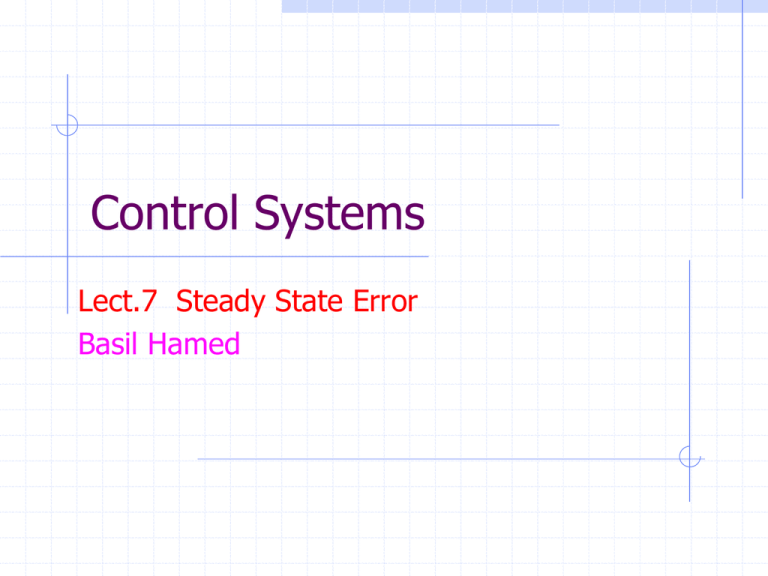
Control Systems Lect.7 Steady State Error Basil Hamed Chapter Learning Outcomes After completing this chapter the student will be able to: • Find the 𝑒𝑠𝑠 for a unity feedback system (Sections 7.1-7.2) • Specify a system's 𝑒𝑠𝑠 performance (Section 7.3) • Design the gain of a closed-loop system to meet 𝑒𝑠𝑠 specification (Section 7.4) • Find the 𝑒𝑠𝑠 for disturbance inputs (Section 7.5) • Find the 𝑒𝑠𝑠 for nonunity feedback systems (Section 7.6) • Find the 𝑒𝑠𝑠 sensitivity to parameter changes (Section 7.7) • Find 𝑒𝑠𝑠 for systems represented in state space (Section 7.8) Basil Hamed 2 7.1 Introduction In Chapter 1, we saw that control systems analysis and design focus on three specifications: (1) Transient Response (Chapter 4) (2) Stability (Chapter 6) (3) Steady-State Errors (Chapter 7) Now we are ready to examine steady-state errors. We define the errors and derive methods of controlling them. Basil Hamed 3 Definition and Test Inputs Steady-state error is the difference between the input and the output for a prescribed test input as 𝑡 → ∞ Test inputs used for steadystate error analysis and design are summarized in Table below. Basil Hamed 4 Application to Stable Systems • Since we are concerned with the difference between the input and the output of a feedback control system after the steady state has been reached, our discussion is limited to stable systems, where the natural response approaches zero as 𝑡 → ∞. • Unstable systems represent loss of control in the steady state and are not acceptable for use at all. • Thus, the engineer must check the system for stability while performing steady-state error analysis and design. Basil Hamed 5 SS Error for Unit Step Input Basil Hamed 6 7.2 Steady-State Error for Unity Feedback Systems Steady-state error can be calculated from a system's closed-loop transfer function, T(s), or the open-loop transfer function, G(s), for unity feedback systems. Steady-State Error in Terms of T(s) To find 𝑒𝑠𝑠 we need to Apply the final value theorem Basil Hamed 7 Example 7.1 P 345 PROBLEM: Find the steady-state error for 𝑇 𝑠 = 5 𝑠2 +7𝑠+10 and the input is a unit step. SOLUTION: From the problem statement, R(s) = 1/s , Since T(s) is stable and, subsequently, E(s) does not have right-halfplane poles or jw poles other than at the origin, we can apply the final value theorem e(∞) = 1/2. Basil Hamed 8 Steady-State Error in Terms of G(s) E(s)= R(s)- C(s); C(s) =G(s) E(s) We now apply the final value theorem Basil Hamed 9 Test Signals The three test signals we use to establish specifications for a control system's steady-state error characteristics are : 1. Step 2. Ramp 3. Parabola Let us take each input and evaluate its effect on the steady-state error by using Eq. Basil Hamed 10 Test Signals Step Input Using Eq. With R(s) = 1/s, we find Ramp Input Using above Eq. with, R(s) = Basil Hamed 𝟏 , 𝐬𝟐 we obtain 11 Test Signals Parabolic Input Using Eq. obtain Basil Hamed with R(s) = 𝟏 𝐬𝟑 , we 12 Example 7.2 P. 347 PROBLEM: Find the steady-state errors for inputs of 5u(t), 5tu(t), and 5𝑡 2 u(t) to the system shown in Figure below. The function u(t) is the unit step. Basil Hamed 13 Example 7.2 P. 347 SOLUTION: First we verify that the closed-loop system is indeed stable. i) 5 u(t); ii) 5tu(t) iii) 5𝑡 2 u(t) Basil Hamed 14 Example 7.3 P 348 PROBLEM: Find the steady-state errors for inputs of 5u(t), 5tu(t), and 5𝑡 2 u(t) to the system shown in Figure below. The function u(t) is the unit step. Basil Hamed 15 Example 7.3 P 348 SOLUTION: First verify that the closed-loop system is indeed stable. i) 5 u(t); ii) 5tu(t) iii) 5𝑡 2 u(t) Basil Hamed 16 7.3 Static Error Constants and System Type We continue our focus on unity negative feedback systems and define parameters that we can use as steady-state error performance specifications. These steady-state error performance specifications are called static error constants. Basil Hamed 17 Static Error Constants For a step input, u(t), 𝑘𝑃 :position constant 𝑒 ∞ = 𝑒𝑠𝑡𝑒𝑝 1 = 1 + 𝑘𝑃 For Ramp input, tu(t), 𝑘𝑣 :velocity constant 𝑒 ∞ = 𝑒𝑟𝑎𝑚𝑝 1 = 𝑘𝑣 Basil Hamed 18 Static Error Constants 1 2 For a parabolic input, 𝑡 2 𝑢(𝑡). 𝑘𝑎 :accelration constant 𝑒 ∞ = 𝑒𝑝𝑎𝑟𝑎𝑏𝑜𝑙𝑎 Basil Hamed 1 = 𝑘𝑎 19 Example 7.4 P 350 PROBLEM: For each system in the Figure below , evaluate the static error constants and find the expected error for the standard step, ramp, and parabolic inputs. Basil Hamed 20 Example 7.4 P 350 SOLUTION: First verify that all closed-loop systems shown are indeed stable. a) Basil Hamed 21 Example 7.4 P 350 b) Basil Hamed 22 Example 7.4 P 350 C) Basil Hamed 23 System Type The values of the static error constants,, depend upon the form of G(s), especially the number of pure integrations in the forward path. Since steady-state errors are dependent upon the number of integrations in the forward path. we define system type to be the value of n in the denominator or, equivalently, the number of pure integrations in the forward path. Therefore, a system with n = 0 is a Type 0 system. If n = 1 or n = 2, the corresponding system is a Type 1 or Type 2 system, respectively. Basil Hamed 24 Example Type 1 Type 2 Type 3 Basil Hamed 25 Relationships between input and system type Type Step Input Ramp Input Parabola Input 0 1 1 + 𝑘𝑃 ∞ ∞ 1 0 1 𝑘𝑣 ∞ 2 0 0 1 𝑘𝑎 3 0 0 0 Basil Hamed 26 Example Find 𝑒𝑠𝑠 for given system , with inputs step, ramp, parabola The closed loop poles are -11.6063 -0.1968 + 0.6261i -0.1968 - 0.6261i Solution: The system is stable and of type 2 Zero SS error for step and ramp input For parabolic input Basil Hamed 27 7.4 Steady-State Error Specifications Static error constants can be used to specify the steady-state error characteristics of control systems. Just as damping ratio, ζ, settling time, Ts, peak time, Tp, and percent overshoot, % OS, are used as specifications for a control system's transient response, so the position constant, Kp, velocity constant, Kv, and acceleration constant, Ka, can be used as specifications for a control system's steady-state errors. For example, if a control system has the specification Kv = 1000, we can draw several conclusions: 1. The system is stable 2. The system is of Type 1 3. A ramp input is the test signal. Basil Hamed 4. 𝑒𝑠𝑠 1 is 𝑘𝑣 28 Example 7.5 P. 354 PROBLEM: What information is contained in the specification Kp = 1000? SOLUTION: The system is stable. The system is Type 0, since only a Type 0 system has a finite Kp. Type 1 and Type 2 systems have Kp = ∞ . The input test signal is a step, since Kp is specified. Finally, the error per unit step is Basil Hamed 29 Example 7.6 P 355 PROBLEM: Given the control system in Figure, find the value of K so that there is 10% error in the steady state. SOLUTION: Since the system is Type 1, the error stated in the problem must apply to a ramp input; only a ramp yields a finite error in a Type 1 system. Thus, k= 672 Basil Hamed 30 7.5 Steady-State Error for Disturbances Feedback control systems are used to compensate for disturbances or unwanted inputs that enter a system. The advantage of using feedback is that regardless of these disturbances, the system can be designed to follow the input with small or zero error. Basil Hamed 31 7.5 𝑒𝑠𝑠 for Disturbances 1 But 2 Substituting Eq. (2) into Eq. (1) and solving for E(s), we obtain 3 To find the steady-state value of the error, we apply the final value theorem3 to Eq. (3) and obtain Basil Hamed 32 Example 7.7 P.357 PROBLEM: Find the 𝑒𝑠𝑠 component due to a step disturbance for the system shown. SOLUTION: The system is stable. The steady-state error component due to a step disturbance is found to be Basil Hamed 33 7.6 Steady-State Error for Nonunity Feedback Systems Control systems often do not have unity feedback because of the compensation used to improve performance or because of the physical model for the system. Basil Hamed 34 Example 7.8 P. 359 PROBLEM: For the system shown, find the system type, the appropriate error constant associated with the system type, and the steady-state error for a unit step input. Assume input and output units are the same. SOLUTION: After determining that the system is indeed stable, one may impulsively declare the system to be Type 1. This may not be the case, since there is a nonunity feedback element, The first step in solving the problem is to convert the system into an equivalent unity feedback system. Basil Hamed 35 Example 7.8 P. 359 we find Thus, the system is Type 0, since there are no pure integrations in above Eq. The appropriate static error constant is then Kp, whose value is The steady-state error, e(∞) is Basil Hamed 36 7.7 Sensitivity • During the design process, the engineer may want to consider the extent to which changes in system parameters affect the behavior of a system. • Ideally, parameter changes due to heat or other causes should not appreciably affect a system's performance. • The degree to which changes in system parameters affect system transfer functions, and hence performance, is called sensitivity. • A system with zero sensitivity (that is, changes in the system parameters have no effect on the transfer function) is ideal. Basil Hamed 37 7.7 Sensitivity For example, assume the function F = K/(K + a) If K = 10 and a = 100, then F = 0.091. If parameter a triples to 300, then F = 0.032. We see that a fractional change in parameter a of (300 — 100)/100 = 2 (a 200% change), yields a change in the function F of (0.032 - 0.091)/0.091 = -0.65 (-65% change). Thus, the function F has reduced sensitivity to changes in parameters. Basil Hamed 38 7.7 Sensitivity Sensitivity is the ratio of the fractional change in the function to the fractional change in the parameter as the fractional change of the parameter approaches zero. That is, which reduces to Basil Hamed 39 Example 7.10 P. 362 PROBLEM: Given the system shown, calculate the sensitivity of the closed-loop transfer function to changes in the parameter a. How would you reduce the sensitivity? SOLUTION: The closedloop transfer function is which is, in part, a function of the value of s. For any value of s, however, an increase in K reduces the sensitivity of the closed-loop transfer function to changes in the parameter a. Basil Hamed 40 Example 7.11 P. 363 PROBLEM: For the system shown, find the sensitivity of the steadystate error to changes in parameter K and parameter a with ramp inputs. SOLUTION: The steady-state error for the system is The sensitivity of e(∞) to changes in parameter a is The sensitivity of e(∞) to changes in parameter K is Thus, changes in either parameter a or parameter K are directly reflected in e(∞) and there is no reduction or increase in sensitivity. The negative sign, indicates a decrease in e(∞) for an increase in K. Basil Hamed 41 7.8 Steady-State Error for Systems in State Space • Up to this point, we have evaluated the steady-state error for systems modeled as transfer functions. • In this section, we will discuss how to evaluate the steadystate error for systems represented in state space (analysis via final value theorem) Basil Hamed 42 Analysis via Final Value Theorem A single-input, single-output system represented in state space can be analyzed for steady-state error using the final value theorem and the closed-loop transfer Consider the closed-loop system represented in state space: The Laplace transform of the error is where T(s) is the closed-loop transfer function, we obtain Applying the final value theorem, we have Basil Hamed 43 Example 7.13 P. 365 PROBLEM: Evaluate the steady-state error for the system shown for unit step and unit ramp inputs. Use the final value theorem. SOLUTION: For a unit step, R(s) = 1/s, and e(∞) = 4/5. For a unit ramp, R(s) = 1/𝑠 2 , and e(∞) = ∞. Notice that the system behaves like a Type 0 system Basil Hamed 44
